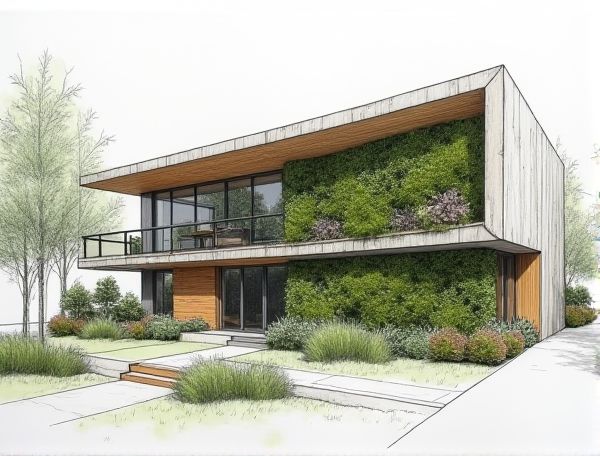
Photo illustration: Biophilic home design with integrated green walls
Incorporating biophilic home design with integrated green walls enhances indoor air quality and fosters a calming connection to nature within your living space. Discover how these natural elements can transform your home environment by reading more in the article.
Introduction to Biophilic Home Design
Biophilic home design integrates natural elements such as sunlight, indoor plants, and organic materials to enhance psychological well-being and improve indoor air quality. Emphasizing connection with nature, this approach promotes sustainable living spaces that reduce stress and increase overall comfort.
Understanding the Benefits of Green Walls
Green walls improve indoor air quality by filtering pollutants and increasing oxygen levels, which enhances your home's overall health environment. They also provide natural insulation, reducing energy costs by maintaining consistent indoor temperatures. Incorporating green walls in your home design promotes sustainability and adds aesthetic value with vibrant, living decor.
Key Principles of Biophilic Interior Architecture
Incorporating natural light, organic materials, and indoor plants enhances the health and well-being of your home environment. Emphasizing spatial harmony and visual connections to nature fosters a calming atmosphere that elevates your everyday living experience.
Choosing the Right Plants for Indoor Green Walls
Choosing the right plants for indoor green walls requires prioritizing species that thrive in low-light conditions and have air-purifying qualities, such as pothos, ferns, and peace lilies. Your selection should consider humidity levels, maintenance needs, and aesthetic goals to ensure a vibrant and sustainable green wall that enhances your living space.
Functional Integration of Green Walls in Home Spaces
Green walls enhance home spaces by improving air quality, regulating indoor temperature, and reducing noise pollution through natural plant filtration. Incorporating these vertical gardens into living areas and kitchens not only boosts aesthetic appeal but also promotes mental well-being and efficient space utilization.
Sustainable Materials for Biophilic Design
Using sustainable materials like reclaimed wood, bamboo, and recycled metal enhances biophilic design by reducing environmental impact while fostering a natural, healthy living space. These eco-friendly resources not only minimize carbon footprint but also improve indoor air quality by avoiding toxic chemicals found in conventional materials. To align Your home design with sustainability goals, prioritize materials certified by organizations such as FSC or Cradle to Cradle for a genuinely green and biophilic environment.
Enhancing Indoor Air Quality with Living Walls
Living walls, composed of various air-purifying plants, naturally filter indoor air by absorbing pollutants and releasing oxygen, significantly improving home air quality. Integrating these vertical gardens into living spaces enhances humidity regulation and reduces airborne toxins, promoting healthier indoor environments.
Smart Irrigation and Maintenance Tips
Smart irrigation systems use soil moisture sensors and weather data to optimize water use, ensuring efficient hydration of plants while reducing waste. Implementing drip irrigation and programmable timers helps maintain consistent watering schedules, promoting healthy growth and conserving resources. Regular maintenance includes checking for leaks, cleaning filters, and calibrating sensors to keep the system operating at peak performance.
Aesthetic Trends in Biophilic Home Interiors
Biophilic home interiors emphasize natural materials, abundant greenery, and organic shapes to create a harmonious connection between indoor spaces and nature. Your design can incorporate living walls, natural light optimization, and earth-toned palettes to enhance both aesthetics and well-being.
Case Studies: Successful Biophilic Homes with Green Walls
Green walls in biophilic homes enhance air quality and increase indoor humidity, creating a healthier environment that promotes well-being. Your design can incorporate these living walls to seamlessly blend nature with modern architecture, exemplified by case studies showcasing improved cognitive function and stress reduction.
 homedesy.com
homedesy.com